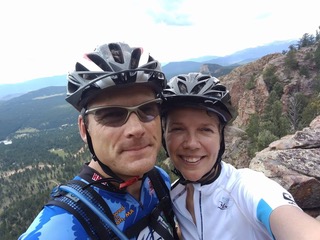
Most trail riders are familiar with the furor that’s erupted from the invention of the electric mountain bike. They may have even taken a stand on one side or the other on the topic. But as eMTBs find their way in the market and on the trails, the mood is changing a little at a time. Most people find that once they ride one — in a real trail experience — their opinions gain more nuance. As a result, access for e-bikes is changing, too.
Local mountain biker and physician Andrew Mapes added an eMTB to his already large fleet of bikes in 2017. “I bought one for the fun factor, and to experience more riding. There were some trails I wasn’t getting to, I wasn’t seeing as much as I wanted, and I wanted to be able to do more. With the e-bike, it feels more like an adventure because a quick ride can now be more like 16-20 miles instead of 9-12.”
Beyond his own enjoyment, he also supports eMTBs for what they can bring to others. “E-bikes are more inclusive and provide access for people. I met a guy who got one after he had a heart attack, and another guy who was partially paralyzed after a car accident. Plus it allows people of different abilities to ride together.”

He experiences that with his own son, who’s 12. “We’re able to ride together more often. It’s lowered the barrier for him to go out, because he’s not going to be forced into so much suffering. Not everyone is built to suffer on a bike, and there’s so much emphasis on that in bike culture. There’s something to be said for being outside, enjoying the experience and being able to share that with someone else.”
Additionally, he often finds that the e-bike removes the need for driving to trails from his home in Golden. “I’m more likely to ride from my house to the trail, and not go in my car, because now I can do that and still get my ride in the allotted time.”
In spite of the benefits, electric mountain bikes have not had an easy road in the U.S., even though manufacturers were probably hoping for the quick adoption seen in Europe.
Here in America, there’s no question that eMTBs have posed a new challenge for land owners, which can be seen from the variety of regulations enacted to deal with them. As eMTB sales began to grow, signs popped up quickly on popular trails in Boulder County, Fruita and Moab, banning eMTBs from most or all of the singletrack.
“From the consumer point of view, it’s a shame that land managers struggle to figure out how to deal with e-bikes,” said Morgan Lommele, Director of State and Local Policy at People for Bikes. “They’re not appropriate in all places, but there are plenty of places where they aren’t a problem. There needs to be a middle ground between banning them everywhere and allowing them everywhere. It’s just a long game.”
On the national level, the United States Forest Service, the Bureau of Land Management, and the National Park Service categorize eMTBs as motorized vehicles, and that means they are banned from the non-motorized trails that regular mountain bikers already enjoy. Here in the mountain west, there is a lot of land owned by these agencies.
However, there is a silver lining in that the USFS and the BLM also have many parcels open to motorized vehicles, mostly meaning motorcycles, so that can often include good singletrack. Although these spots aren’t always close to urban areas, they make up for it in spice and variety. “That’s the fun thing about e-bikes to me, you can go a little farther to explore trails you might not check out on your regular bike. You can go exploring on Forest Service motorized land because you have good battery range and won’t get as tired,” Lommele said.
And on the state level, there is a lot to appreciate. “Colorado is one of the best states for riding close to home, and having true singletrack experiences,” Lommele said. A key part of that was the decision by Colorado State Parks to allow eMTBs in all the areas that currently allow mountain biking. Golden Gate Canyon State Park and Staunton State Park are two great options for riders living on the Front Range, with Golden Gate in particular offering narrow, rocky trails for experienced riders.
For opportunities right here in the foothills, Jefferson County Open Space allows e-bikes on all trails already open to mountain bikes. “That’s an example of a proactive land manager looking ahead at trends,” Lommele said. “They ran a year-long pilot program in 2018 to figure out how to accommodate e-bikes, and for the most part people didn’t have major problems with them.” At the end of the study, JeffCo allowed the bikes permanently, giving riders access to parks like Apex, White Ranch and Matthews/Winters, which includes the black diamond trail Dakota Ridge.
Lommele has found that most eMTB owners are already mountain bikers, so often they want to go beyond their home trails to travel and ride in destination locations in Colorado and beyond. She points out that many of the scenic, fun places to ride bikes are still an option for these riders. The Monarch Crest in Salida is open to e-bikes, as is Hartmann Rocks in Gunnison. Classic Crested Butte backcountry routes like Reno/Flag/Bear/Deadman’s Gulch have long been open to motorized use and are outstanding options on an e-bike. To see many more destination rides, check out the People for Bikes webpage, which has a wealth of information about where to ride and find adventures:
https://peopleforbikes.org/our-work/e-bikes/rides-and-routes/
All this said, there are still a couple of areas of concern for e-bike owners. Although it can be easy to blend in with regular bikes, it’s important not to ride trails closed to e-bikes. Closures are frustrating, but they represent the current decisions that land managers have made for the lands they own. Violating those decisions will only reflect badly on mountain bikers as a whole, who have spent many years advocating for their place in the trails community. “Access is a privilege,” said Mapes. “If you want to have more access, campaign to make a change. Educate people and change minds.”
“If you don’t speak up, no one will listen or know you have a concern,” Lommele said. “Riders need to speak up to their land managers, to lead to better access down the road.”
Author: Marty Caivano, Sports Garage Contributor
Marty is an experienced journalist and veteran of the mountain biking industry. She co-founded Smart Cycling Service in 2017, and manages consumer-facing events for a broad variety of manufacturers.

































 Photo: Yeti Cycles @annegalyean
Photo: Yeti Cycles @annegalyean